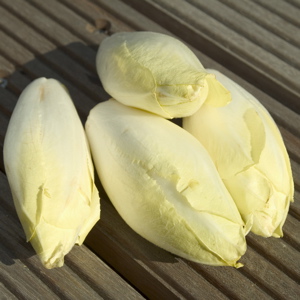Endive
 |
Cream-colored Belgian endive (witloof) is grown in complete darkness to keep it from turning green. |
Varieties
There are three main varieties of endive:Belgian Endive
Also known as French endive or witloof (white leaf), this tightly-packed head of leaves is cream-colored, cigar-shaped and slightly bitter. It's grown in complete darkness to keep it from turning green. This labor-intensive process (called blanching) is what makes Belgian endive so expensive.
Curly Endive
Often (mistakenly) called chicory in the United States, this loose head of prickly leaves has a slightly bitter taste. The outer leaves are lacy, green-rimmed and curled at the tips, while the off-white center leaves form a compact heart.
Escarole
These broad, slightly curved, pale green leaves have a milder flavor than both Belgian and curly endive.
History
Belgian endive was first produced in 1830, by accident. The story goes that Jan Lammers, a Brussels farmer, stored chicory roots in his cellar, intending to dry and roast them for coffee (a common practice in 19th century Europe). But when Lammers returned to his farm after serving in the Belgian War of Independence, he had achieved quite different results. The roots, having rested for several months in the dark, had sprouted small, white leaves. Curious, Lammers took a taste and found the leaves to be tender, moist and crunchy.Buying Tips
Belgian Endive: Available from September through May, with a peak season from November through April. Look for crisp, firmly-packed heads with pale, yellow-green tips.Curly Endive and Escarole: Available year-round, with a peak season from June through October. Look for heads with fresh, crisp texture and avoid any with discoloration or insect damage.
Storage Tips
Belgian Endive: Wrap in paper towel, place in a plastic bag and refrigerate for no more than a day. It becomes bitter when exposed to light.Curly Endive and Escarole: Tightly wrap and refrigerate for up to three days.
Usage Tips
• Add all varieties of endive to fresh salads.• Serve cold with salmon, caviar, cheeses and dips.
• Enjoy with pears, raspberries, blueberries and a spritz of lemon juice.
• Cook Belgian endive by braising or baking.
• Briefly cook curly endive or escarole and serve as a vegetable side dish or stir into soups.
Try one of our favorite endive recipes:
Barbecued Shrimp Salad





